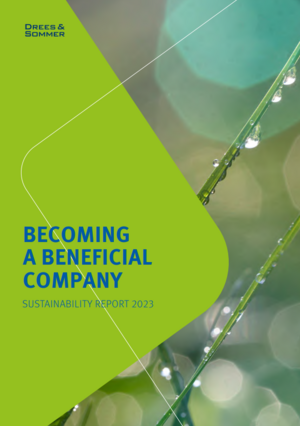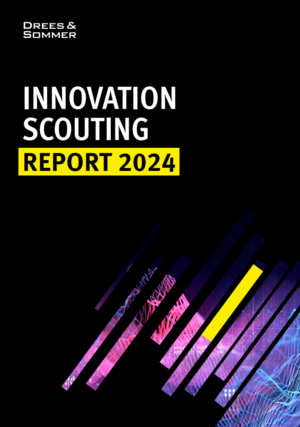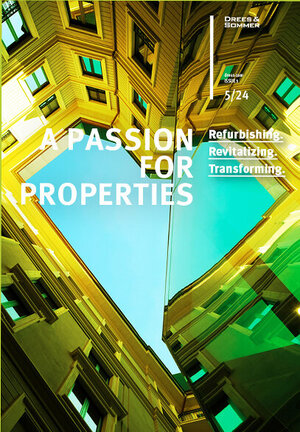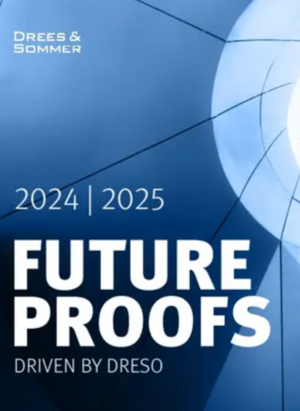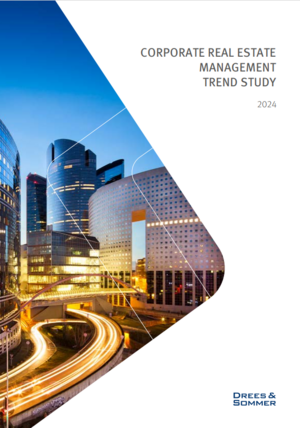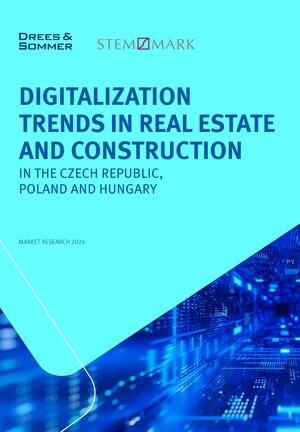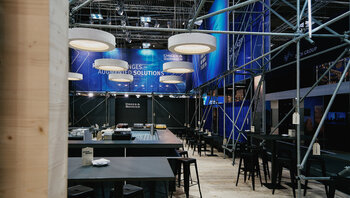Stuttgart, Germany, December 1, 2021. Building houses while also protecting the climate and conserving resources – the gap here is still much too wide. Drees & Sommer SE, a consulting firm specializing in construction and real estate, demonstrates an alternative in the new net plus energy building at Obere Waldplätze 12 (known as OWP12). It is being opened today at the corporate campus in Stuttgart’s Vaihingen district. Winfried Kretschmann, Minister-President of the German State of Baden-Württemberg, and Stuttgart’s Lord Mayor, Dr. Frank Nopper hailed the showcase project as a blueprint for climate-friendly construction, an inspiration for the entire buildings sector. Drees & Sommer invested around EUR 22 million in the office building, digitally designed with green credentials. After two years of construction work, on schedule and within budget, it now provides space for around 200 employees.
The new office block provides answers to the climate crisis and represents the switch to renewable energy sources in the buildings sector. The net plus energy building was designed to be recyclable as far as possible, generating more energy than it consumes in operation. This will be achieved in part by a newly developed, highly insulated façade construction, photovoltaic systems on the roof and on the southern façade, the use of geothermal energy via geothermal boreholes, and the greening of the northern façade. The Cradle to Cradle principle (C2C) was used to ensure the building's recyclability, the absence of harmful substances, and ease of dismantling. As a result, construction materials can be recycled in high quality, or returned to a biological cycle, after a building has been demolished at a later date. Information on the materials used and their chemical composition is provided by a material passport.
For Minister-President Winfried Kretschmann, the consistent focus on sustainability is seen as a game-changer for future construction projects: ‘The construction and real estate industries have special responsibility when it comes to sustainability. Landmark projects such as Drees & Sommer's new building show how the transformation to a sustainable and climate conscious construction culture can succeed. Two factors are particularly important: recyclable materials that don't end up in the garbage at the end of their useful life, and an energy supply from renewable sources that can provide sustainable power not only for the company's own needs, but also for the neighborhood. In our strategic dialog on affordable living and innovative building solutions we will also discuss these issues in depth.‘
According to Steffen Szeidl, Spokesperson of Drees & Sommer’s Executive Board, trying out and applying forward-looking approaches itself is part of the firm's DNA: ‘For more than 50 years now, we have been advising public and private building owners on how to make their buildings fit for the future. Our new building is a blueprint for how flexible, intelligent and environmentally friendly properties can be realized in very short periods of time. The best way to prove to our clients what is worthwhile and economically viable is to demonstrate it by leading the way.‘
Clear Commitment to the Location
Professor Dr. Hans Sommer, founder of the company and Supervisory Board Chairperson, sees one particular highlight in the new construction project: a good balance between economic success and corporate responsibility for the environment and society. ‘In all our projects, we aim to combine economy and ecology. To do so, we work with strong partners on the latest developments, we find out what is feasible, and we lead the way by putting it into practice. Now it's a matter of taking the innovations from our own new building to our 4,000 or more client projects.‘
For Lord Mayor Dr. Frank Nopper, Drees & Sommer as a company can look back on an exceptional past spanning more than 50 years, a story that is closely linked to Stuttgart. ‘It all started with a team of three, now the company has 1,000 employees in Stuttgart alone, and 4,000 worldwide. Drees & Sommer is the number one in its field in Europe and has played a leading role in a large number of projects in Stuttgart. The new OWP 12 building on the Vaihingen campus is another highlight, especially for sustainable construction methods. As a city, we will continue to support the company as it expands – a model for other firms.’
More than just a Wallflower
What makes the building so special can already be seen from the outside: a green façade, designed along with the Vertiko company, covers more than 100 square meters and is home to various species of plants and insects throughout the year. This vertical garden filters pollutants, insulates traffic noise and has a positive impact on microclimate and biodiversity. The building shell is impressive: the highly insulating and energy-generating façade, which was developed jointly with the FKN Group and Evonik, is space-saving and was designed in line with the principles of the circular economy. The materials used can therefore be recycled or reused accordingly after their service life. Combined with photovoltaic systems and geothermal energy via geothermal boreholes, these are the main methods of supplying the building with energy from renewable sources.
For the technical building equipment inside the building, Drees & Sommer worked with the Würth Group, a company based in Künzelsau, Germany. They jointly designed recyclable modules that can be manufactured on an industrial scale, offering considerable time and cost benefits in the design, production and assembly phases.
Built Using Digital Methods, Real in Operation
The company is also setting standards in digital processes. Ideas, drafts, simulations, time schedules, specifications, budgets, building permits: to coordinate all this, the interaction of all those involved had to function extremely well. So, for smooth project flow, the company relied on the digital planning method Building Information Modeling (BIM). Before the first digger moved in, the finished building could be explored in its digital twin, from the basement to the roof. Inconsistencies in the planning or construction were detected at the digital model stage and corrected before they could cause delays on the building site.
Even after completion, everyday digital assistants will make their way into employees' working lives and help keep energy consumption low. Apps can be used, for example, to grant access authorizations, book conference rooms or allocate parking spaces in the car park. They can also adjust heating, cooling, ventilation and lighting settings automatically to suit individual needs. Drees & Sommer worked together with cooperation partners Phoenix Contact and Solo Lightning on the IT and sensor technology solutions required for this.
About OWP 12
The new building is 20 meters high and 70 meters long. It offers a gross floor area (GFA) of around 7,000 square meters and features a large conference area, a terrace, a cafeteria and a staff restaurant. The office building will accommodate 200 employees. The net plus energy house is intended to be more than just an administrative building; it will also act as a showcase for potential clients.
You can find the building images here: Fotos OWP12
Follow the link for further detailed information on the building and video links: CONSTRUCTION OF NEW OFFICE BUILDING OBERE WALDPLÄTZE 12, STUTTGART (dreso.com)

![[Translate to English:]](https://cdn.dreso.com/fileadmin/_processed_/f/b/csm_OWP12_Ansicht_Vorderseite__c__Juergen_Pollak__2__cdea346c6b.jpg)
